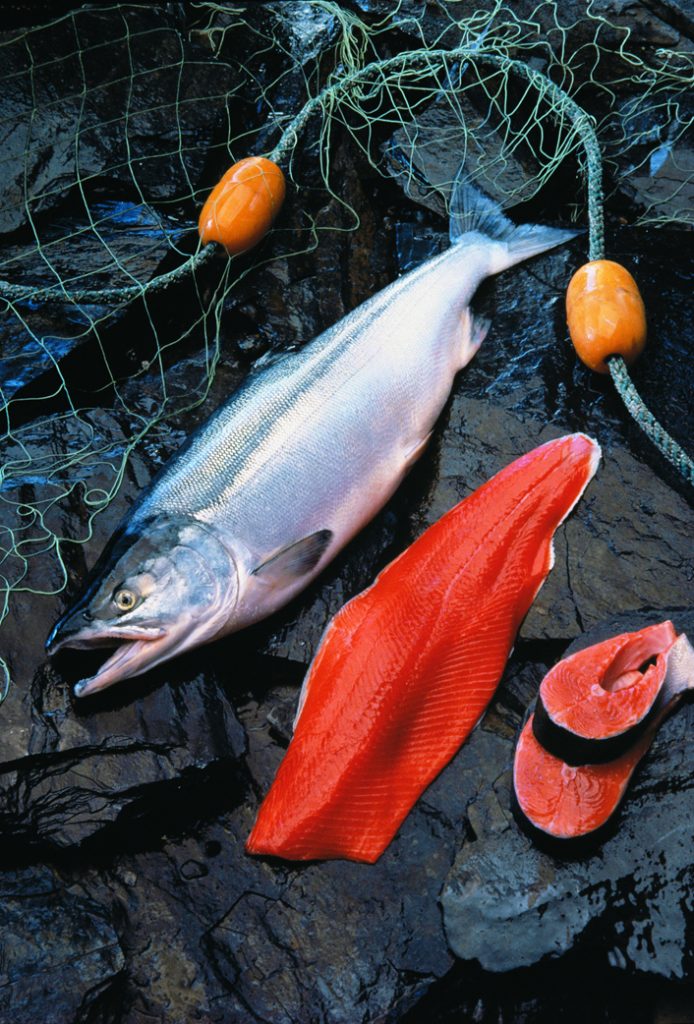
With Diabetes now affecting Americans at epidemic levels (and growing every year), researchers are scrambling to find solutions to this problem. Everyone wants to know why this is happening and what we can do about it. Some of the answers are obvious, like eating a balanced diet and getting more exercise. Â But what does it mean, exactly, to eat a balanced diet? Well, recent studies show that eating wild salmon regularly can not only help prevent Type 2 diabetes, but may also slow the effects of diabetes in those that are already suffering from the disease.

Sockeye Salmon, Look at That Unmistakable Color
In short, Wild Salmon has the power to:
And those are only the ways wild salmon can fight diabetes. The Omega-3 fatty acids in salmon are connected with a whole slew of other health benefits, including heart, brain, and eye health, as well as maternal and infant health.
* I think it is important to note here that only WILD salmon contains these beneficial properties. Farmed salmon contains unhealthy levels of Omega 6 fatty acids, which actually increase inflammation, and dangerous levels of Persistent Organic Pollutants like PCBs, which are linked with metabolic syndrome, insulin resistance and Type 2 Diabetes. For more information on the connection between farmed salmon and Type 2 Diabetes, check out this study.
The following is an excerpt from a paper titled "Benefits of Omega-3 Fatty Acids from Fish in Type 2 Diabetes," by Joyce A. Nettleton, DSc, RD
"Omega-3 fatty acids, found mainly in fat-rich fish such as salmon, rainbow trout, mackerel, and sardines confer health benefits not found in other foods. Omega-3s from fish are highly polyunsaturated fatty acids that lower triglycerides, reduce abnormal heart rhythms, reduce blood pressure by small but significant amounts, and improve blood clotting regulation. In a large study of more than 11,000 people with heart disease, the daily consumption of about one gram of fish oil reduced cardiovascular mortality by 30% and sudden cardiac death by 45%. A gram of fish oil is equivalent to a 3 ounce serving of salmon. Omega-3s may also boost the effectiveness of statins, drugs widely prescribed to lower blood LDL cholesterol levels.Studying populations such as the Alaskan and Greenland Inuit, who frequently eat fatty fish or marine animals rich in omega-3s, has taught us a great deal. Traditionally, these native people have had very little cardiovascular disease or diabetes. Japanese, who also consume large amounts of fish, have much lower rates of heart disease and diabetes than Americans. As these populations adopt western eating habits and exercise less, their prevalence of obesity and diabetes soars. Could the onset of diabetes be changed if native people at risk for the disease resumed eating more omega-3 rich foods? Dr. Sven Ebbesson of the University of Virginia sought the answer in a study of 44 Alaskan Inuit who had early signs of diabetes €“ impaired glucose tolerance and excess weight. Inuit were asked to eat fewer foods high in saturated fats and more traditional foods, especially fish and marine animals. After 4 years, not a single person had advanced to type 2 diabetes, in spite of not losing weight. This promising study needs to be confirmed in a larger number of subjects. Omega-3 fatty acids may be particularly beneficial for overweight people with hypertension who are on weight loss diets. Dr. Trevor Mori and colleagues at the University of Western Australia recently showed that people on a weight loss diet that included fat-rich fish daily had improved glucose and insulin metabolism. People on the same diet without fish had no such improvements. Both groups lost the same amount of weight, but blood pressure reduction was greater among the fish eaters than the non-fish eaters. Even in people not losing weight, the inclusion of fish every day reduced blood pressure. Thus, people with diabetes who eat rich fish on a regular basis can boost the benefits of weight loss in improving glucose control and blood pressure. Finally, it has been known for years that omega-3s from fish reduce the likelihood of developing blood clots that lead to heart attacks and stroke. They also improve blood circulation. These benefits have been demonstrated in controlled clinical trials and occur without unfavorable changes in glucose or insulin activity. The American Diabetes Association and the American Heart Association advocate eating fatty fish as a safe and effective way to obtain the heart health
benefits of omega-3s. Eating fatty fish regularly is an important strategy to improve health in diabetes."

salmon and rice salad
The evidence in support of wild salmon is pretty overwhelming. As part of a healthy lifestyle, salmon is an essential weapon in the battle against Type 2 Diabetes!
For more reading about the connections between wild salmon and diabetes, explore the links below...